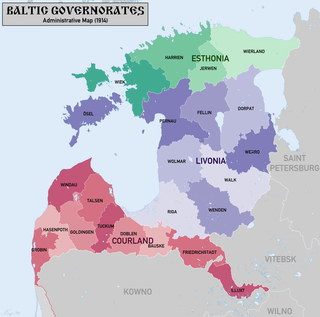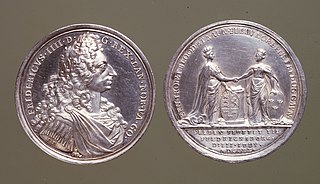
The Great Northern War (1700–1721) was a conflict in which a coalition led by the Tsardom of Russia successfully contested the supremacy of the Swedish Empire in Northern, Central and Eastern Europe. The initial leaders of the anti-Swedish alliance were Peter I of Russia, Frederick IV of Denmark–Norway and Augustus II the Strong of Saxony–Poland–Lithuania. Frederick IV and Augustus II were defeated by Sweden, under Charles XII, and forced out of the alliance in 1700 and 1706 respectively, but rejoined it in 1709 after the defeat of Charles XII at the Battle of Poltava. George I of Great Britain and the Electorate of Hanover joined the coalition in 1714 for Hanover and in 1717 for Britain, and Frederick William I of Brandenburg-Prussia joined it in 1715.

The Treaty of Nystad was the last peace treaty of the Great Northern War of 1700–1721. It was concluded between the Tsardom of Russia and the Swedish Empire on 10 September [O.S. 30 August] 1721 in the then Swedish town of Nystad. Sweden had settled with the other parties in Stockholm and in Frederiksborg (1720).

The Dominions of Sweden or Svenska besittningar were territories that historically came under control of the Swedish Crown, but never became fully integrated with Sweden. This generally meant that they were ruled by Governors-General under the Swedish monarch, but within certain limits retained their own established political systems, essentially their diets. Finland was not a dominion, but a land of Sweden. The dominions had no representation in the Swedish Riksdag as stipulated by the 1634 Instrument of Government paragraph 46: "No one, who is not living inside the separate and old borders of Sweden and Finland, have anything to say at Riksdags and other meetings..."

Swedish Livonia was a dominion of the Swedish Empire from 1629 until 1721. The territory, which constituted the southern part of modern Estonia and the northern part of modern Latvia, represented the conquest of the major part of the Polish-Lithuanian Duchy of Livonia during the 1600–1629 Polish-Swedish War. Parts of Livonia and the city of Riga were under Swedish control as early as 1621 and the situation was formalized in the Truce of Altmark 1629, but the whole territory was not ceded formally until the Treaty of Oliva in 1660. The minority part of the Wenden Voivodeship retained by the Polish–Lithuanian Commonwealth was renamed the Inflanty Voivodeship, which today corresponds to the Latgale region of Latvia.

Viborg and Nyslott County was a county of the Swedish Empire from 1634 to 1721. The county was named after the castle towns of Viborg and Nyslott, today located in the towns of Vyborg in Russia and Savonlinna in Finland.

Kexholm County was a county of the Swedish Empire from 1634 to 1721, when the southern part was ceded to the Russian Empire in the Treaty of Nystad. The capital of the county was Kexholm, which today is Priozersk.
The Treaties of Stockholm are two treaties signed in 1719 and 1720 that ended the war between Sweden and an alliance of Hanover and Prussia.

The Baltic governorates, originally the Ostsee governorates, was a collective name for the administrative units of the Russian Empire set up in the territories of Swedish Estonia, Swedish Livonia (1721) and, afterwards, of the Duchy of Courland and Semigallia (1795).

Left-bank Ukraine is a historic name of the part of Ukraine on the left (east) bank of the Dnieper River, comprising the modern-day oblasts of Chernihiv, Poltava and Sumy as well as the eastern parts of Kyiv and Cherkasy.

The Treaty of Frederiksborg was a treaty signed at Frederiksborg Castle, Zealand, on 3 July 1720, ending the Great Northern War between Denmark–Norway and Sweden.

Vyborg Governorate was an administrative-territorial unit (guberniya) of the Russian Empire. It was established in 1744 in newly ceded territories from Sweden following the Treaty of Åbo and parts of Saint Petersburg Governorate which were previously ceded by Sweden in 1721 as a result of the Great Northern War.

The Russo-Persian War of 1722–1723, known in Russian historiography as the Persian campaign of Peter the Great, was a war between the Russian Empire and Safavid Iran, triggered by the tsar's attempt to expand Russian influence in the Caspian and Caucasus regions and to prevent its rival, the Ottoman Empire, from territorial gains in the region at the expense of declining Safavid Iran.

Primorsk is a coastal town in Vyborgsky District of Leningrad Oblast, Russia and is the second largest Russian port on the Baltic, after St. Petersburg. It is located on the Karelian Isthmus, 137 kilometers (85 mi) west of St. Petersburg, at the northern coast of the Gulf of Finland, near Beryozovye Islands which are protected as a sea bird sanctuary. Population: 6,119 (2010 Census); 5,332 (2002 Census); 6,637 (1989 Census).

The Treaty of Tartu is a peace treaty that was signed in Tartu on 2 February 1920 between the Republic of Estonia and Soviet Russia, ending the 1918–1920 Estonian War of Independence. In the treaty, Bolshevik Russia recognized the independence of the newly established democratic state of Estonia.

The Battle of Kalisz took place on 29 October 1706 in Kalisz, Polish–Lithuanian Commonwealth during the Great Northern War. The battle was fought by Russian cavalry along with allied Saxon and Polish forces, led by commander Aleksandr Menshikov; against a smaller Swedish force headed by colonel Arvid Axel Mardefelt and resulted in an allied victory. By this time the Polish forces under Augustus the Strong had signed a peace treaty with the Swedes, but August had delayed informing his Russian allies, leading to the battle.
Truce/Treaty of Vilna or Truce/Treaty of Niemieża was a treaty signed at Niemieża near Vilnius on 3 November 1656 between Tsardom of Russia and Polish–Lithuanian Commonwealth, introducing a truce during the Russo-Polish War (1654–67) and an anti-Swedish alliance in the contemporaneous Second Northern War. In return for ceasing hostilities and fighting Sweden alongside Poland–Lithuania, the treaty promised Alexis of Russia succession in Poland after John II Casimir Vasa's death. The Cossacks under Bohdan Khmelnytsky were excluded from the negotiations, and subsequently supported the Transylvanian invasion on the Swedish side.

With the Capitulation of Estonia and Livonia in 1710 the Swedish dominions Estonia and Livonia were integrated into the Russian Empire following their conquest during the Great Northern War. The Livonian nobility and the city of Riga capitulated on 4 July (O.S.) / 15 July 1710 (N.S.), Pernau (Pärnu) in August, and the Estonian nobility and the city of Reval (Tallinn) on 29 September (O.S.) / 10 October (N.S.). Russia left the local institutions in place and confirmed the traditional privileges of the German nobles and burghers as was established in Privilegium Sigismundi Augusti, especially with respect to the Protestant faith. The land reform of the so-called reduction which had been introduced by the Swedish king Charles XI, and transformed many serfs to subjects of the Crown, was reversed.
Kymmenegård and Nyslott County was a county of Sweden from 1721 to 1747.

Events from the year 1721 in Sweden
Events from the year 1805 in Russia















